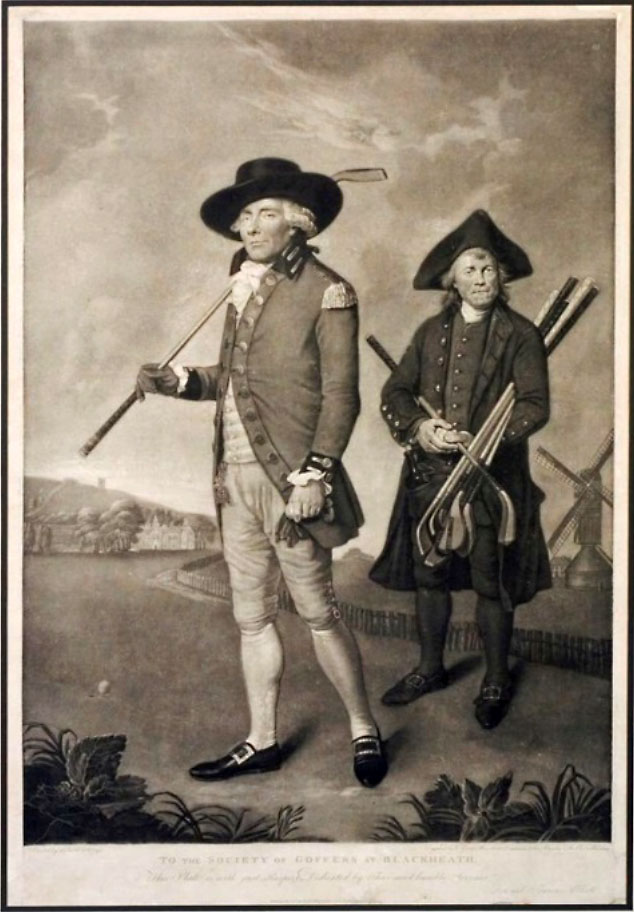
By John Fischer III
February 2019
My future wife once asked why I had a picture on the wall of George Washington playing golf. She would later become an excellent golfer playing in local and state competitions, but then new to the game she had never seen a print of the Blackheath Golfer, one of golf’s most famous and recognizable. While there are some earlier golf related paintings, the Blackheath Golfer was the first print with a golf theme and has been widely reproduced.
The Blackheath Golfer has a long, and sometimes confusing, history. William Innis, a wealthy London sugar merchant and captain of the Society of Golfers at Blackheath, commissioned Lemuel Francis Abbott to paint his portrait, “full-size,” in 1790. Innis is depicted wearing a long red coat befitting his distinction as captain. Holding a club over his shoulder, he’s accompanied by one of the many retired sailors in the area who served as caddies. They’re shown on the heath near Greenwich, England, then an arduous trip from London that included a boat ride down the Thames.
Golf came to Blackheath in 1603 after James I of Scotland, heir apparent to Elizabeth I, moved to the royal palace at Greenwich accompanied by a large retinue of nobles, many of whom were also golfers.
When the portrait was painted, there were 45 members in the Society of Golfers at Blackheath, today constituted as the Royal Blackheath Golf Club. Matches were played over a five-hole course, after which players retired to a local tavern for food and drink, golf clubhouses not appearing until the 1840s. It has been said that golf was just an excuse to get to the tavern, but many took the game seriously. When, during a medal contest at Blackheath, Innis lost his feathery ball, he appealed for a ruling; the penalty imposed for a loss of ball was then disqualification. Still, there must have been a lightheartedness to the Society. Fines and dues were paid in claret or beer with matches settled in the same coin.
The painting was displayed in the parlor of the Innis home in London, but it had a much broader audience for shortly after it was painted, Valentine Green produced a mezzotint engraving of the painting dedicated to “The Society of Goffers at Blackheath.” It is believed that the original engraving was produced in a run of 50 prints, enough for sale to each member of the Society of “Goffers,” of which 15 originals are thought to remain today.
The Green mezzotint would be copied many times, often accompanied at the bottom by the phrase: “Engraving by V. Green Mezzotint engraver to his Majesty and the Elector Palatine.” If you have one with that legend it’s probably not one of the remaining 15, but how do you know?
The original engraving was in black and white although some are thought to have been hand colored. The original image is 17-by-23 inches, while most reproductions are smaller. There are other versions of the Blackheath Golfer, including an 1893 black and white platinotype, a photographic print which captures details excellently, hard to distinguish from an engraving. In the early 20th century a black and white photogravure print was produced. These were copied from the original Valentine Green engraving.
Also in the early 1900s a new color mezzotint engraving of the Blackheath Golfer was made by Will Henderson and published by Vicars Brothers, 12 Old Bond Street, London, and signed “Will Henderson” in pencil. It clearly has an identity of its own, and is a separate work of art like the Valentine Green mezzotint, although not as scarce. Around the same time Walter Cox painted a new Blackheath Golfer which appears similar to the Green mezzotint in structure, but which is clearly different with softer definitions. Original prints were signed by Cox in pencil.
Recently a photographic print known as a “Giclee” has been made from an original Green mezzotint. The Giclee process uses an ink jet printer. The resulting image appears identical to the original and very difficult to differentiate.
So where is the original Abbott painting? Said to have been lost in a fire, an unsubstantiated rumor places it with a Japanese collector and another has it in a private collection in the county of Fife, Scotland. In fact it seems the painting went to Innis’s wife upon her husband’s death. Innis and his wife, Ann, had what today would be called an open marriage for he had a relationship with an Agnes Palmer which produced three children. All seemed to get along with each other; when Ann Innis died she willed the painting to Innis’s illegitimate daughter, who in turn gave it to her brother, William Palmer, who deeded it to his son, Henry.
Henry Palmer was a British Army officer who served in India when native personnel within the British Army revolted — the Indian Mutiny of 1857. As reported in his memoirs, Palmer’s house was burned to the ground with all contents destroyed including “an oil painting, full size, of a gentleman standing in a field, holding a golf club.”
Was that the original Blackheath Golfer? Probably so, as suggested by this piece of circumstantial evidence. At least no one has advanced a better theory to date.
Because the Valentine Green mezzotint is a copy from the painting made by hand on an engraving plate, the fact the painting was “full-size” does not mean the mezzotint wasn’t smaller. Many engravings copied from portrait paintings are smaller than the original which were often life size. Engraving is an intaglio process in which the paper is pressed against the engraved plate after the plate has been covered with ink and then wiped clean. The image on the plate is produced by the ink in the depressed parts of the plate.
To produce a mezzotint a copper plate is roughed with a special tool called a “rocker” to produce tiny dots which are filled with ink. The engraver is able to produce various shades of black and gray by modifying the size of the tiny dots instead of just black and white. The mezzotint allows for intricate shading, tones and texture, especially useful in depicting clothing. Original Valentine Green mezzotints of the Blackheath Golfer can be found at the USGA Museum in Far Hills, N.J., and the British Golf Museum in St. Andrews.
My Blackheath Golfer — George Washington — is a photogravure in color reproduced from a Green original. It is water stained, giving it the appearance of age and authenticity, and in a nice fruitwood frame. It is handsome, but not valuable – the frame may be worth more than the print – but the point of art is to enjoy it.
